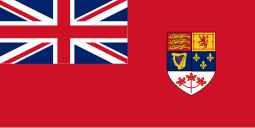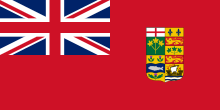Canadian Red Ensign
 | |
| Red Ensign used from 1957 to 1965 | |
| Use | Civil ensign[note 1] |
|---|---|
| Proportion | 1:2 |
| Adopted | 1957 (earlier versions in 1892 and 1922)[note 2] |
| Relinquished | 1965 |
| Design | A red field, featuring the Royal Union Flag in the canton, defaced with the shield portion of the coat of arms of Canada. |
The Canadian Red Ensign (
The Canadian Red Ensign emerged as an informal flag to represent Canada as early as the 1870s and was used at sea
Description
The ensign is the
History

 Canadian Red Ensign used from 1868 to 1922. Several informal variations of the ensign were produced in that time, altered by manufacturers' whims and the addition of other provincial arms on the ensign.
Canadian Red Ensign used from 1868 to 1922. Several informal variations of the ensign were produced in that time, altered by manufacturers' whims and the addition of other provincial arms on the ensign.The Red Ensign bearing some sort of a Canadian emblem was used by Canadians both on land and at sea beginning as early as 1868 (soon after

 Canadian Red Ensign used from 1922 to 1957
Canadian Red Ensign used from 1922 to 1957The original Canadian Red Ensign had the arms of the four founding provinces on its shield. However, in the late 19th and early 20th century, flag manufacturers would often supplement this design with wreaths of laurel and oak leaves and crowns. The design was frequently placed on a white background square, circle or roughly following the outline of the arms in the flag's fly (right hand side assuming the flagpole to be on the left). There was no standard design for the Red Ensign until the early 1920s. In 1921, the Government of Canada asked
The Red Ensign served as the country's civil ensign from 1892 to 1965 when it was replaced by today's
In 2007, the Canadian Red Ensign was formally recognized as a "national symbol of Canada," by the Public Register of Arms, Flags and Badges of Canada.[8]
Vimy Ridge Red Ensign

The Red Ensign carried by the 5th Canadian Infantry Battalion (Western Cavalry) at the Battle of Vimy Ridge in 1917 survives to this day, and is possibly the oldest Canadian flag in existence.[9] The battle was the first time all four divisions of the Canadian Expeditionary Force fought together during the First World War, and is viewed as a pivotal event in the history of Canadian national identity.[10][11]
The Red Ensign flown at Vimy Ridge in 1917 had the arms of Canada's first four provinces. In the Royal Warrant of 1868 assigning arms to the first four provinces of Canada, Queen Victoria authorized them to be quartered for use on the Great Seal of Canada and thus de facto they became the arms for Canada until 1921.
The Imperial War Museum refused requests over the years to
Eventually, after months of negotiations involving the Royal Canadian Legion, the Imperial War Museum agreed to lend the flag to Canada to commemorate the opening of the new Canadian War Museum in Ottawa in 2005. The flag was returned to the United Kingdom in 2008.[13][9][14]
There is another Red Ensign in existence that was reportedly carried by Canadian troops at the Battle of Vimy Ridge, currently held by the Penticton Museum and Archives in Penticton, British Columbia. It is a simple red ensign, without a coat of arms.[13][9]
Usage today

Though much less common than either the Maple Leaf or modern provincial flags, the several versions of the Canadian Red Ensign continue to be flown today both in official and unofficial capacities. In view of its association with the Canadian Army during the world wars, it is flown alongside the Maple Leaf flag at numerous war memorials, including the Canadian National Vimy Memorial in France. It is also used by veterans' groups, and is part of the official colour party (together with the Maple Leaf) of the Royal Canadian Legion. The flag is sometimes flown on vintage ships, and at heritage sites where it is historically accurate.
In the 2010s, some
The flag's appropriation by white supremacists has produced an outcry from several groups, including the Royal Canadian Legion, the Canadian Centre for the Great War, and the editor of the history journal The Dorchester Review, who have expressed the view that "trivializing, or treating as a kind of talisman of defiance, a flag that has a much more venerable and mainstream role" is not right and "flies in the face of what the Red Ensign means".[15]
Variations
Before the adoption of the new arms of Canada in 1921, flag makers made the badge larger each time a new province joined Confederation. This led to the creation of several unofficial but widely used variants of the Canadian Red Ensign.
At the opening ceremony of the 1936 Olympic Games, a variant of the 1922–1957 red ensign with the arms inside a white disc was carried by Canadian Olympian and flag bearer James Worrall. However the normal version of the red ensign without the disc was hoisted alongside the other national flags that surrounded the perimeter of the stadium.[17]
Some of the variations are shown below.
-
 1868: The Canadian Red Ensign used at July 1 Dominion Day celebrations in Barkerville, BC in support of Canadian Confederation, as Canada did not have an official flag.[18]
1868: The Canadian Red Ensign used at July 1 Dominion Day celebrations in Barkerville, BC in support of Canadian Confederation, as Canada did not have an official flag.[18] -
 1873: The flag was modified to represent the new provinces of British Columbia and Prince Edward Island. The badge was always placed on a white disk in this edition.
1873: The flag was modified to represent the new provinces of British Columbia and Prince Edward Island. The badge was always placed on a white disk in this edition. -
 1896: British Columbia adopted a new coat of arms.
1896: British Columbia adopted a new coat of arms. -
 1907: Alberta and Saskatchewan were added to the flag. The coats of arms of British Columbia, Prince Edward Island, and Manitoba took on their modern forms.
1907: Alberta and Saskatchewan were added to the flag. The coats of arms of British Columbia, Prince Edward Island, and Manitoba took on their modern forms. -
 Flag with 1922-1957 disc. The flag was carried by James Worrall at the opening ceremony of the 1936 Olympic Games.
Flag with 1922-1957 disc. The flag was carried by James Worrall at the opening ceremony of the 1936 Olympic Games.
Provincial
Today, two Canadian
Canadian Blue Ensign

 The Canadian Naval Jack used from 1957 to 1965
The Canadian Naval Jack used from 1957 to 1965The Canadian
In 1937, the Canadian Government established that the Canadian Blue Ensign ("the Blue Ensign of the Dominion of Canada") would be used as a special ensign by the several Canadian yacht clubs which had prior to then used the British Blue Ensign (either plain or defaced) as their special ensign. This usage lasted until the 1965 introduction of the Maple Leaf flag. Today, some Canadian yacht clubs use the Canadian Blue Ensign to commemorate this usage.
In art and culture
Otto Reinhold Jacobi included a red ensign flying from the East Block in his 1866 painting of the Parliament Buildings.
During the early 1990s an
Notes
- ^ The Canadian Red Ensign was also viewed as an unofficial flag of Canada from the early 20th century to 1965. However, the ensign was never formally adopted as a national flag.
See also
- British ensign
- Canadian Naval Ensign
- Historical flags of the British Empire and the overseas territories
- National symbols of Canada
- Royal Canadian Air Force Ensign
References
- ^ a b Colombo, John Robert (1 April 2021). "Canadian Red Ensign". www.thecanadianencyclopedia.ca. Historica Canada. Retrieved 31 January 2023.
- ^ "Canadian Red Ensign". www.gg.ca. Governor General of Canada. Retrieved 31 January 2023.
- ^ a b c d "History of the National Flag of Canada". canada.ca. Department of Canadian Heritage. 4 February 2020. Retrieved 25 January 2021.
- ^ a b Despatch No. 311, 12 December 1891, GG's Office, file 290A, Vol. 1, 1865-1937.
- ^ "Arms & Badges - Royal Arms of Canada, A Brief History". Royal Heraldry Society of Canada. Retrieved 10 August 2019.
- ^ George Stanley, The Flags of Canada.[page needed]
- ^ a b "Ensigns". fraser.cc. Retrieved 1 November 2019.
- ^ "A flag comes back to the fold". The Globe and Mail. The Woodbridge Company. 2 May 2007. Retrieved 8 March 2020.
- ^ a b c d e Wattie, Chris (2002). "Britain finally yields, will lend Vimy Ensign". National Post.
- ^ Inglis, Dave (1995). Vimy Ridge: 1917–1992, A Canadian Myth over Seventy Five Years. Burnaby: Simon Fraser University.
- ISBN 978-0-88920-508-6.
- ISSN 0269-9222.
- ^ a b c "Flag, Red Ensign, Canadian". Imperial War Museums. Archived from the original on 23 May 2013. Retrieved 30 April 2013.
- ^ a b "Britain loans Canada Red Ensign carried by Canadians at Vimy Ridge". CBC News. 17 July 2002. Archived from the original on 9 November 2012. Retrieved 30 April 2013.
- ^ a b c Hamilton, Graeme (10 July 2017). "Former Canadian flag, the Red Ensign, gets new, darker life as far-right symbol". National Post. Retrieved 12 July 2017.
- ^ Kamel, Zachary; Patriquin, Martin; Picazo, Alheli (8 February 2019). "Maxime Bernier's alt-right problem". The Toronto Star. Retrieved 10 June 2019.[permanent dead link]
- ^ "1936 Berlin Olympics Opening Ceremony". YouTube. International Olympic Committee. Archived from the original on 12 December 2021. Retrieved 12 February 2013.
- ^ "Dominion Day and the "New" Canadian Flag". Barkerville Historic Town & Park. 1 July 2019. Archived from the original on 2 August 2019. Retrieved 2 August 2019.
- ISBN 978-0-7748-1088-3.
- ^ "Ontario (Canada)". Flags of the World. Archived from the original on 18 January 2000. Retrieved 19 September 2021.
- ^ "Manitoba (Canada)". Flags of the World. Archived from the original on 4 November 1999. Retrieved 19 September 2021.
- ^ Carr, H. Gresham Flags of the World 1961
- ^ Mikkelson, David P. (20 February 2007). "Red Ensign Scare". Urban Legends Reference Pages. Retrieved 31 August 2007.
External links
- Red and Blue Ensigns, Canada History including chronology
- The Flags of Canada by Alister B. Fraser
- Canada – history of the flag (1867–1870)
- Canada – history of the flag (1870–1873)
- Canada – history of the flag (1873–1892)
- Canada – history of the flag (1892–1907)
- Canada – history of the flag (1907–1922)
- Canada – history of the flag (1922–1957)
- Canada – history of the flag (1957–1965)
- Flags of the Royal Canadian Navy 1910–1965

![1868: The Canadian Red Ensign used at July 1 Dominion Day celebrations in Barkerville, BC in support of Canadian Confederation, as Canada did not have an official flag.[18]](http://upload.wikimedia.org/wikipedia/commons/thumb/4/4c/Caribou_Canadian_Flag.png/120px-Caribou_Canadian_Flag.png)










